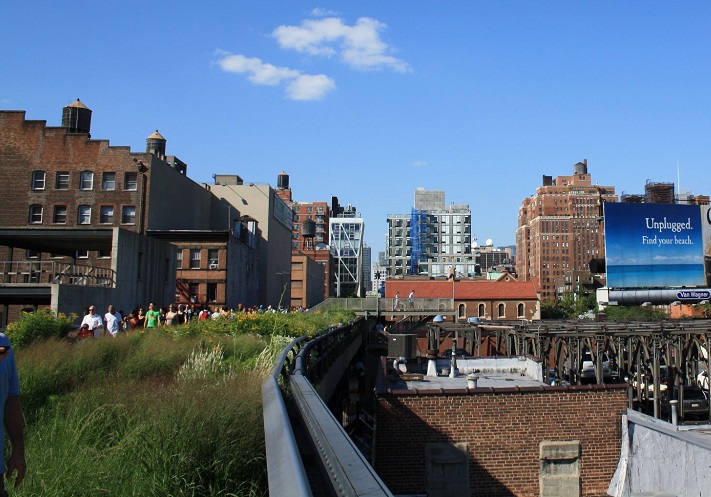Landscape urbanism
Landscape urbanism is the theory of urban planning through the medium of landscape. It promotes the general idea that cities are best planned and organised, not through building and infrastructure design, but through the design of landscape.
Since emerging in the mid-1990s, landscape urbanism has taken several different forms and interpretations. It was popularised by American landscape architects who used the term to refer to the reorganisation and planning of post-industrial cities such as Detroit and others that were in decline. By the late-2000s, the term had come to be used in reference to high-profile projects of urban renewal, often with commercial investment, such as London's Olympic Park.
Other projects that are seen as being influenced by landscape urbanism include; the High Line in New York, Millennium Park in Chicago, the Olympic Sculpture Park in Seattle, and Parc de la Villette in Paris.
As a theory, landscape urbanism originated in the late-1980s, when landscape architects and urbanists such as Peter Connolly, Richard Weller and Charles Waldheim began to explore the perceived boundaries and limits of their respective disciplines within the context of complex urban projects. The first Landscape Urbanism conference was held in Chicago in 1997, following which, academic programmes in America and Europe began to formalise the emerging practice in institutions such as the University of Toronto, Harvard Graduate School of Design, Massachusetts Institute of Technology, and Oslo School of Architecture.
These theorists sought to 'claim landscape as urbanism' and viewed the concept as a reaction to 'architecture and urban design's inability to offer coherent and convincing accounts of contemporary urban conditions'.
In essence, the theory suggests that landscape should supplant architecture from its traditional role as the foundation for urban form. In terms of a project this may be achieved through managing infrastructure, water, biodiversity and human activity, and examining the ecological and environmental implications of the urban development.
One of the leading theorists, James Corner, suggested the most important ideas for landscape urbanism are:
- Process over time: Ecological awareness with regard to the built environment.
- Horizontality: Horizontal alignment in landscapes, as opposed to vertical structuring.
- Working methods/techniques: Techniques should be adapted to the relevant environment.
- Imaginary: The failure of 20th century planning is a result of 'the absolute impoverishment of the imagination to extend new relationships and sets of possibilities.'
Critics of landscape urbanism point to its stubborn resistance to clarity in terms of a common methodology or even an easy definition. It is argued that it remains an abstract academic theory that uses obscurantist post-modern language with few actual built examples to draw from.
[edit] Related articles on Designing Buildings Wiki
- Biophilia and building design.
- Brasilia Syndrome.
- Charles Waldheim - Landscape as Urbanism: A General Theory.
- Concept design.
- Contextualism.
- Fallingwater.
- Garden cities.
- Green space.
- Landscape architect.
- Landscape institute.
- Living in the hyperreal post-modern city.
- Location.
- Megacity.
- Monument and context.
- Parametricism.
- Place.
- Psychogeography.
- Speculative architecture.
- Street furniture.
- The landscapes of Cambridge.
- The Lowline.
- Trinity River Park.
- Urban design.
- Urban fabric.
[edit] External references
- Scenario Journal - Landscape urbanism
- 'Landscape as Urbanism: A General Theory', WALDHEIM, C., Princeton University Press (2016)
Featured articles and news
The UK's Modern Industrial Strategy: A 10 year plan
Previous consultation criticism, current key elements and general support with some persisting reservations.
Building Safety Regulator reforms
New roles, new staff and a new fast track service pave the way for a single construction regulator.
Architectural Technologist CPDs and Communications
CIAT CPD… and how you can do it!
Cooling centres and cool spaces
Managing extreme heat in cities by directing the public to places for heat stress relief and water sources.
Winter gardens: A brief history and warm variations
Extending the season with glass in different forms and terms.
Restoring Great Yarmouth's Winter Gardens
Transforming one of the least sustainable constructions imaginable.
Construction Skills Mission Board launch sector drive
Newly formed government and industry collaboration set strategy for recruiting an additional 100,000 construction workers a year.
New Architects Code comes into effect in September 2025
ARB Architects Code of Conduct and Practice available with ongoing consultation regarding guidance.
Welsh Skills Body (Medr) launches ambitious plan
The new skills body brings together funding and regulation of tertiary education and research for the devolved nation.
Paul Gandy FCIOB announced as next CIOB President
Former Tilbury Douglas CEO takes helm.
UK Infrastructure: A 10 Year Strategy. In brief with reactions
With the National Infrastructure and Service Transformation Authority (NISTA).
Ebenezer Howard: inventor of the garden city. Book review.
The Grenfell Tower fire, eight years on
A time to pause and reflect as Dubai tower block fire reported just before anniversary.
Airtightness Topic Guide BSRIA TG 27/2025
Explaining the basics of airtightness, what it is, why it's important, when it's required and how it's carried out.
Construction contract awards hit lowest point of 2025
Plummeting for second consecutive month, intensifying concerns for housing and infrastructure goals.
Understanding Mental Health in the Built Environment 2025
Examining the state of mental health in construction, shedding light on levels of stress, anxiety and depression.
The benefits of engaging with insulation manufacturers
When considering ground floor constructions.
Lighting Industry endorses Blueprint for Electrification
The Lighting Industry Association fully supports the ECA Blueprint as a timely, urgent call to action.
























